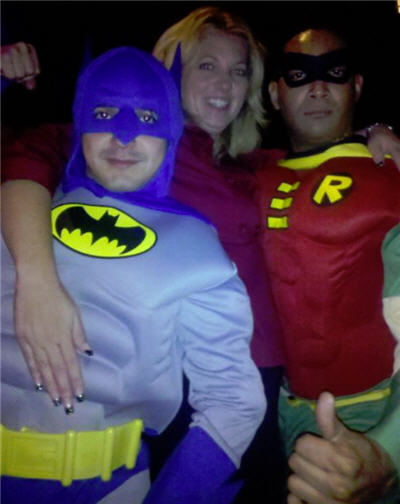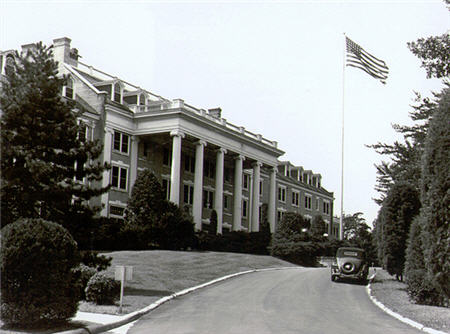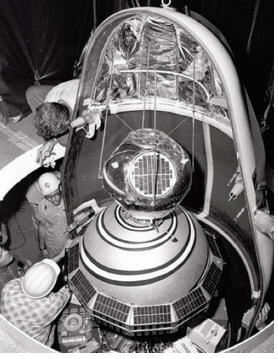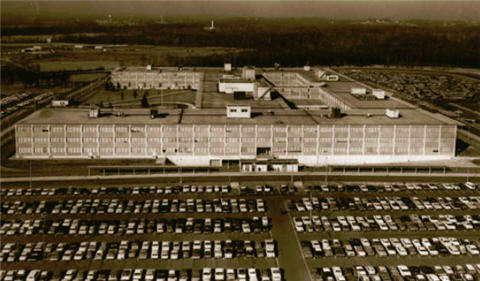Why One

Peter was behind the bar, which means that this undated interview happened sometime before he either got fired or decamped downtown on his own volition. There is no one who could pour a more infuriating martini- the surface tension alone held the precious liquid in the glass, making it almost impossible to take the first sip with any grace. Normally I would use one of the small cocktail straws to draw down the level a bit and make in manageable, even if I had to hunch over the bar like Quasimoto to accomplish it. I miss Peter and whoever his little assistant was- I remember they dressed up as Batman and Robin on one of Tracey O’Grady’s spectacular Halloween parties. He was the first of the long-time bartenders to depart and make our little circle of barflies smaller. So, given the bar staff, I have to guess that this was a conversation in 2008 or 2009, back when Mac Showers and I were just getting rolling on the project.
He talked a lot about Arlington Hall Station, and it resonated with me, since the station is just across the street from the building where I live, and the cemetery just up the road contains the graves of many Japanese-Americans, which Mac explained was not unexpected, since the neighborhood was a nest of spies for years, since the Army took over the former girl’s school to make it their number one codebreaking installation, the book end to Navy’s occupation of the academy for young women on Nebraska Avenue.
I learned my lesson on Peter’s martinis, which were as potent as they were full, and was careful to stipulate the Happy Hour white wine, which in this case was a nice Flora Springs Napa Valley Chardonnay, 2004. At five bucks a glass, it was a good deal and kept us all coming back. Well, that might not have been the reason, since Jon-Without-an-H drank vodka and soda and Old Jim would not tolerate anything but Budweiser in a long-neck brown bottle. No accounting for taste.

(Headquarters Building at Arlington Hall Station, Arlington, VA).
Confirming that it was a Napa wine are the color of the stains on the napkins on which I had taken notes. I honestly do not know how we got to taking about the Navy codebreakers who had moved into Arlington Hall after the war. The new and chilling relation with the Soviet Union brought the National Security Act of 1948, and a new consolidated organization to handle the COMINT missions of the military departments. The new organization was dubbed the Armed Forces Security Agency (AFSA), and was stood up in DoD on May 20, 1949.”
“I have visited the Key West White House where Mr. Truman worked on the Act. I think I would have just stayed down there. Was the process as confusing as I think it was?”
“Short answer is ‘Yes,'” Mac said. “In theory, the AFSA was to direct the communications intelligence and electronic intelligence activities of the military service signals intelligence units, which now included the brand new Air Force. In practice, the AFSA had little power, its functions being defined in terms of activities not performed by the service components. The answer, it appeared, was the creation of the National Security Agency, which sprang full-blown from the forehead of Walter Bedell Smith in a December 1951 memo to James B. Lay, Executive Secretary of the National Security Council. The memo observed that “control over, and coordination of, the collection and processing of Communications Intelligence had proved ineffective” and recommended a survey of communications intelligence activities. The proposal was approved on December 13, 1951, and the study authorized on December 28, 1951.”
“Aha!” I said triumphantly. “Our first Blue Ribbon Panel on intelligence failures!”
“Certainly not the last in my career,” Mac said with an ironic smile. “The report was completed by June, 1952. We called it the “Brownell Committee Report,” after the chairman. The thing was a survey of the history of U.S. communications intelligence activities. It came to the conclusion that there was a need for a much greater degree of coordination and direction at the national level.”
“Time for a name change, which is often the only way to move the deckchairs around on a sinking ship. The role of NSA was clearly going to extend far beyond the armed forces, and the facilities at Arlington Hall were not going to be adequate to the scope of the new mission.” At least that is what the histories say. I preferred just hearing it from a guy who was there.
We may have gotten to this since I had been relating a story that Louie, the former Chief of Staff at DIA, had told me about being a young analyst at Arlington Hall. When DIA was just starting and housed on the Arlington Hall campus, he worked in the Soviet Shop with a Navy Commander who had the irritating habit of removing his shoes when he came in the office, only putting them back on when the work day was done. When it came time for his to execute his Permanent Change of Station orders, Louie got even by nailing the empty shoes to the wooden floor of the ‘temporary’ office building. Mac was mildly amused, and mentioned that the windows on the Secure Compartmented Information Facility were drafty- the only time he had that problem with a SCIF. I asked him about his experiences at Arlington Hall.
“Well, I worked at Y-1 I worked in Y-1 between ’46 and ’48. Admiral Frost was the DNI when I came back to Washington from FIRST Fleet, and I had worked for him, of course, when he was a Captain. He was originally Y-1 in 1946, and I saw him frequently until I went to London. Admiral Frost, in the mean time, had gone off to do fleet duty or whatever. It was non-intelligence assignment, and then he returned after making admiral as the DNI. I 1 m not sure of the year. But he was the DNI when I returned to Washington in the spring of 1957 to take over Y-1. I found Y-1 much as I had left it, except enlarged. There were more people, different people, although some were the same. Maury Hellner and Ed Nielson were still there, Dr. Ed Haff was there. All of them had been hired into Y-1 as civilians; those three were civilians when I was there the first time, and they were still there. Maury stayed there during most of my tour, and Ed Nielson continued for a little while. Ed Haff had, I think moved over into the Pentagon into “F” branch just after I got there. But all those three people, who became high level analysts and well-recognized in ONI were first hired in naval intelligence service in Y-1 and cut their teeth doing Y-1 analysis. They did a creditable job all the time. The active duty officers assigned there were, of course, rotating, so the fact that I had been gone from Y-1 for seven years meant only the civilian cadre remained. Well, except for LCDR Barbara Conard- her married name was ‘Moore,’ if you want to check her out. But she too had other assignments while I was gone before returning. She was one of the original Y-1 group that we had at Nebraska Avenue in 1948.”
“I knew one of the women who worked there in the war. She wouldn’t talk about it, and freaked out that I knew about it, even though her work had been declassified decades before. Was she an intelligence officer by designation?”
“No. Barbara was a WAVE. And you don’t use that term anymore, I don’t believe. You call them “women officers.”
“They changed that to General Unrestricted Line- pronounced “GURL,” which seemed mildly sexist to me when I was in the personnel business, and trivialized the contributions of the WAVES. But now everyone can be a warfare specialist, even the Spooks. They even have a little badge to wear that says so.”
“I started as a Deck Officer, so I understand. But Barb was a Wave. She did not have a Special Duty- Intelligence designator. She had been on an assignment in New York and someplace else and then she came back to Y-1. I think she had been there about a year when I arrived back in 1957, and she stayed another year and then she received another assignment. But, other than that, a lot of the people were new. We had two or three Ensigns who were Naval Academy graduates but because of physical deficiencies, mainly eyesight, had been commissioned as intel and then had gone through Intelligence School. That program started when I was at the Intelligence School, and it had continued with three or four such officers a year. Some of them were on duty in Y-1, and some of them became career intel officers. That includes Admiral Bob Schmitt, who first worked in Y-1 as an Ensign, as did future DNI RADM Torn Brooks. And we moved to Fort Meade. The organization was larger, but the organizational structure that we had originally created still existed. There were some additional mission areas and simply more people assigned to do the increased volume of work. The products being put out were increased because of increased personnel, and the growing volume of raw material being provided.”
“What accounted for that, Sir? New collection systems coming on line?”

(GRAB Satellite, forerunner of orbital ELINT collection systems).
“Yes. There were land-based sensors that provided comprehensive HF/DF information and information on Soviet radar emissions and communications. Navy was the first of the Services to go to space with the 1960 launch of the Galactic Radiation and Background (GRAB) satellite, the cover name for the first of the ELINT collectors. POPPY was the follow-on system, which might have still been on orbit when you joined up. That was the mainstay of the U.S. Navy’s orbital ELINT collection capability for almost 15 years. It started out as a general search system whose mission was to map out the locations and capabilities of Soviet radar systems, but gained capability and data volume over time as new electronic systems were added to each launch.”
“It became a sea of data and now they are talking about it all floating around in a cloud. I am glad I no longer have to deal with it,” I said, sipping some of the Flora Springs.

(NSA’s Operations Building #1, Fort Meade, MD).
“So it was not hard to fit right back into Y-1 when I returned, and we lived in North Arlington, so the commute was a breeze. The first issue I was confronted with after reporting was the fact that we were soon going to move to Fort Meade. I had no prior knowledge that NSA was building a headquarters building at Fort Meade and all that went with that. But when I arrived there in the spring of 1957, the construction at Fort Meade was well along. The headquarters building was due to be occupied later in the year. Many elements of NSA had already moved. When they created the NSA compound at Fort Meade, the first thing they constructed was the barracks for the Marine guards. These were three or four reinforced concrete, two-story buildings near the NSA headquarters building. Several elements of NSA were temporarily housed in these barracks buildings until the headquarters was completed. So, at the very beginning of my tour that Spring, we had to make liaison visits to some of the NSA elements at Fort Meade, and we went out on a few occasions and worked with the NSA people in these barracks buildings, which was rather disorganized and temporary, but nevertheless NSA was already operating on a split basis. So, we continued our planning for the move through the year, and, in December of 1957, we actually made our physical move. All the rest of NSA moved, and Y-1 moved along with it, in December 1957 and everybody took up full residence at the new headquarters building at Fort Meade at the same time. That opened a new era of activity with Y-1, which in the meantime had been re-designated the “Navy Field Operational Intelligence Office.” I always have to stop and think because of the difficulty of that title and the artificiality of it. I still to this day refer to the activity as Y-1, and I believe I always will. It’s an easier thing to say.”
“I totally agree about NFOIO’s name. But we had to acknowledge and use it, since they were the Gods of OPINTEL when I was out in the Pacific. What they said about the Soviet subs and merchant shipping was considered authoritative, and us Spooks out in the hustings were just the Junior Varsity.”
“That was the nature of the Ocean Surveillance Information System.”
“I am proud that I got to be part of the OSIS system,” I said, “We used to say that working at one of the Centers or Facilities was like trying to write a newspaper on the floor of the New York Stock Exchange.”
“Dave Rosenburg wrote a book about it called ‘The Admiral’s Advantage,’ said Mac. “He talked to me extensively on the origins and function of the system. We had the intelligence nodes of the system around the world- London, Rota, Pearl and Kami Seya. Sitting on top was Y1. You should be proud that you got to see one of the finest OPINTEL systems ever devised. But as to the NFOIO name, it was all Beltway politics and centers of gravity. At that time, Fort Meade was outside of what was defined as the metropolitan area, Washington, D.C. Fort Meade was geographically within the area of the Severn River Naval Command. I don’t know whether the Severn River Naval Command, as an administrative organization, still exists.
“Most of those commands have long gone away,” I said, wondering if there was a good time to step out and grab a smoke.
“I haven’t heard of the Severn River Command in years, but it was real, and led by the Superintendent of the Naval Academy. He was double-hatted to run the Naval Academy and the Severn River Naval Command. We fell within his geographical limits, so that was the reason that the activity was designated the field office of ONI located outside the Washington metropolitan area and why I was given additional duty orders to report to the Commandant of the Severn River Naval Command, who technic ally was my military superior.”
“And with whom you had very little business?”
“Almost nothing. I did go down to Annapolis to show we could play nice. I took Commander Ed Cummings with me, he was Y-lE, my production manager, and he was an Academy graduate. I’d never been to the Naval Academy before. I didn’t know my way around, so I figured I could use a ring-knocker to keep me on course.”
“Just to stay calibrated on this napkin, where were you in your career? Did you have your twenty years at that point?”
“Right on twenty in that tour, and just made Captain, so I had no thought about retiring. I was having too much fun. So, I took Ed with me to make my call on the Superintendent and to do all the necessary protocol niceties. And we did that; we had a nice discussion with him. We couldn’t tell him very much, because he wasn’t indoctrinated for our business, but he wasn’t overly inquisitive, so I’m sure he had many things of his own concern, and we were not very important to him. But he said he would designate one of his staff officers to be our point of contact for whatever business we might have. He designated Captain Fluckey who had already had some intelligence duty. I think that’s why he designated him.
“That would be “Lucky” Fluckey? The submariner who landed a sabotage party ashore in Japan to blow up a train during WWII?”
“And later Director of Naval intelligence. I knew him slightly at that time, and he was on duty in the Academy’s Electrical Engineering Department. So we continued our call and went over to see Captain Fluckey, and he was very receptive to us, very helpful, and said he would do anything that we needed help with. The only direct contact of a continuing nature we had with the Naval Academy was to transfer some funds from ONI for Severn River Naval Command, since we had to be paid by them, and they, of course, had no budget to cover our activity. So ONI transferred funds annually from the ONI budget to the Severn River Naval Command supply officer or comptroller, and he would issue the paychecks for our civilians.
“At Y1, were you working directly for the DNI? In terms of the content of your work, there was no intervening command? Did anyone at NSA check your work?”
“Absolutely not. We worked directly for the DNI, as we had been part and parcel of ONI. In fact, we still showed the Y-1 organization with the Y-1 designators on the ONI directory, the ONI Roster, with NFOIO simply put in parenthesis after my name. So, for all practical purposes, we were still ONI. But the important thing was, and this became significant later to other people, the important thing was that the personnel in Y-1 no longer counted against the headquarters establishment of OPNAV. It became significant because it led people to discover that you could create field activities and move them out of the immediate area, or out of the Pentagon, and thus reduce your OPNAV manpower ceiling while still having the organization in place, effective, and working for you. Since we were the first field activity of ONI, and we were created because of our geographic separation, it became a forerunner of what is now effect, field activities of ONI.”
“And you also provided a template for how other offices in the Pentagon to do such things?”
“Right,” he said with a slight grimace. “We are responsible for the sprawl. Little by little other activities were moved out of the Pentagon to the Hoffman Building in Alexandria and out to Suitland and were created as field activities of ONI, and subsequently NAVINTCOM was created to be the umbrella over all of these field activities representing the DNI.”
“Was being at Fort Meade any more of a handicap in getting your needs across and getting your support to the DNI?”
“No, it was no handicap because I continued to live in North Arlington. I started out each day from Arlington and returned to Arlington each evening, and, if need be, I could start my day in the Pentagon or finish my day in the Pentagon and not be grossly dislocated because I could simply change my schedule. In the beginning, most of our other officers also lived in the Virginia area, where we had all been in order to work at Arlington Hall. Some of the people relocated their households out to the Maryland countryside or to the Laurel vicinity. There were were no quarters available on the Post. Many people continued to live in Northern Virginia. I found it quite convenient to do so because I would, whenever necessary, spend a half a day in the Pentagon, either in the morning or in the afternoon or conceivably all day. But the wildest commute was that done by Captain Bill Hatch. He was determined to raise his family away from the big city and owned a farm out in Leesburg. He would drive to Arlington long before dawn and we would car pool to Ft. Meade.”
I gave a low whistle. “That might be the worst commute in Washington,” I said.
“And remember: it was before the Beltway, which didn’t get finished until 1964, and by that time I was on my way to Pearl Harbor again. Remind me to tell you about what the commuting was like one of these afternoons.”
“Yessir.” I asked Peter for the check, and counted myself lucky that I might have made my last drive to Fort Meade. At least on official Business, anyway.
Copyright 2017 Vic Socotra
www.vicsocotra.com
